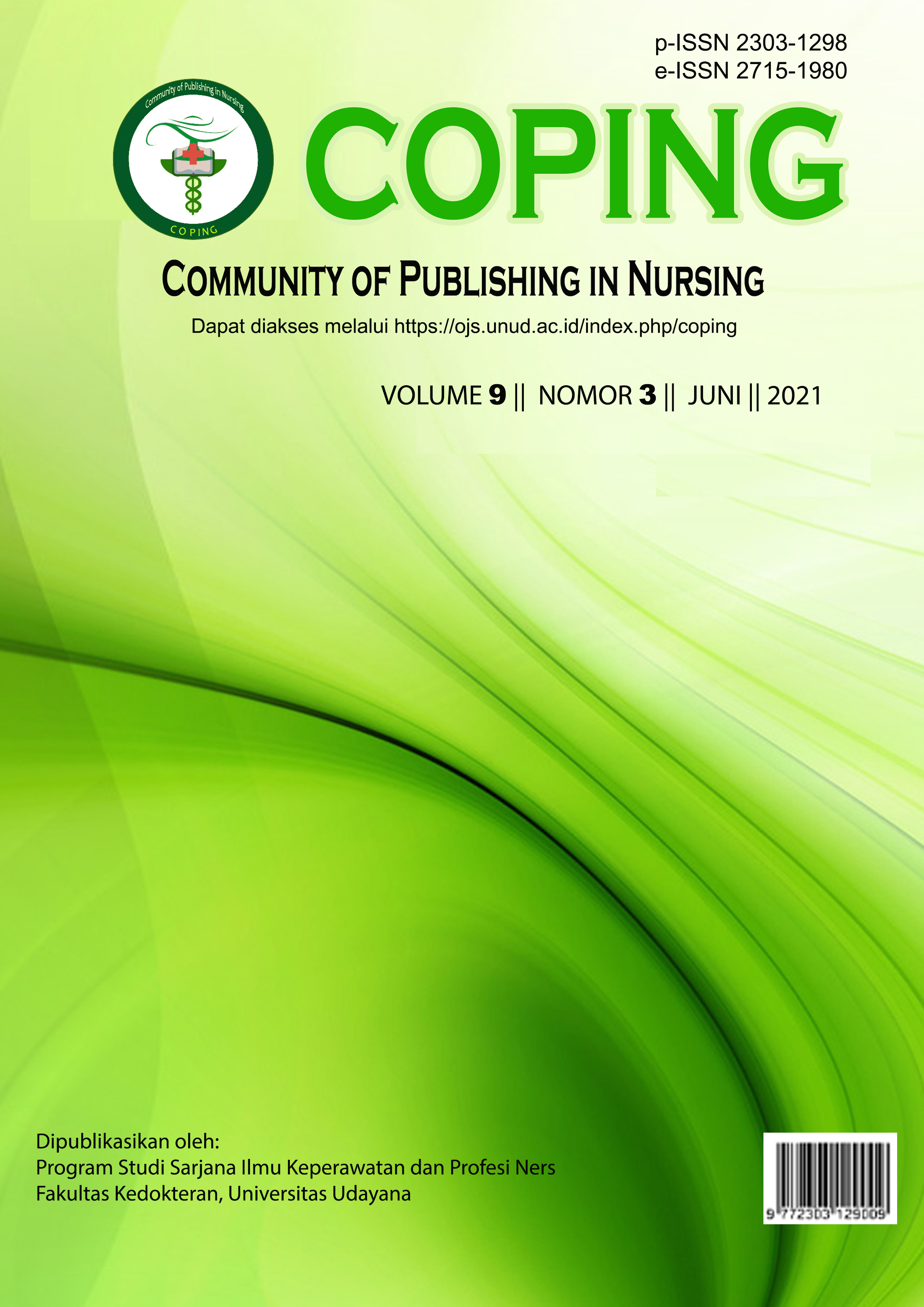HUBUNGAN ANTARA HEALTH LOCUS OF CONTROL DENGAN KEPATUHAN MENJALANI TERAPI HEMODIALISIS PADA PASIEN GAGAL GINJAL TERMINAL
Abstract
Kidney failure is a chronic renal disease that has the characteristics of decreasing the glomerular filtration rate to <15 ml/min/1.73m2 and is irreversible. Patients are required to have hemodialysis as their life sustaining treatment. Health Locus of Control (HLC) is one of the factors that can affect the patient’s adherence in the hemodialysis therapy. This study was purposed to determine the relationship between health locus of control and adherence of hemodialysis therapy on patients with kidney failure. A correlative descriptive study with cross-sectional approach was implemented as the design of this study. Respondents of 100 people were obtained through a purposive sampling technique. Spearman rank test was applied to get the data analysis. The results showed that there were a positive weak relationship between internal HLC and adherence (r=0.236; p-value=0.018; ?=0.05), a positive moderate relationship between powerful others HLC and adherence (r=0.416; p-value=0.001; ?=0.05) and there was no relationship between chance of HLC and adherence (p-value=0.564; ?=0.05). It is expected that this research can inform nurses in improving patients’ adherence in hemodialysis therapy
Downloads
References
Bener, A. (2011). High Prevalence of Depression, Anxiety and Stress Symptoms Among Diabetes Mellitus Patients. The Open Psychiatry Journal, 5(1), 5–12. https://doi.org/10.2174/1874354401105010005
Bolman, C., Arwert, T. G., & Völlink, T. (2011). Adherence to prophylactic asthma medication: Habit strength and cognitions. Heart & Lung, 40(1), 63–75. https://doi.org/10.1016/j.hrtlng.2010.02.003
Caninsti, R. (2013). Kecemasan dan Depresi pada Pasien Gagal Ginjal Kronis yang Menjalani Terapi Hemodialisis. Jurnal Psikologi Ulayat, 1, 16.
Fithria, F., & Isnaini, M. (2014). Faktor-faktor yang berhubungan dengan kepatuhan berobat pada penderita hipertensi di klinik Sumber Sehat Indrapuri Aceh Besar. Idea Nursing Journal, 5(2), 56-66.
Ghimire, S., Peterson, G. M., Castelino, R. L., Jose, M. D., & Zaidi, S. T. R. (2016). Medication Regimen Complexity and Adherence in Haemodialysis Patients: An Exploratory Study. American Journal of Nephrology, 43(5), 318–324. https://doi.org/10.1159/000446450
Grotz, M., Hapke, U., Lampert, T., & Baumeister, H. (2011). Health locus of control and health behaviour: Results from a nationally representative survey. Psychology, Health & Medicine, 16(2), 129–140. https://doi.org/10.1080/13548506.2010.521570
Hudak, C. M., & Gallo, B.M. (2010). Keperawatan kritis: Pendekatan holistic (6th ed.) Jakarta: EGC
INDONESIAN RENAL REGISTRY. (2017). 40.
Izzati, W., & Annisha, F. (2016). Faktor-Faktor yang Berhubungan dengan Kepatuhan Pasien yang Menjalani Hemodialisis di Ruang Hemodialisa Di RSUD Dr. Achmad Mochtar Bukittinggi Tahun 2015. 3, 30.
Kammerer, J., Garry, G., Hartigan, M., Carter, B., & Erlich, L. (2007). Adherence in Patients On Dialysis: Strategies for Success. NEPHROLOGY NURSING JOURNAL, 34(5), 10.
Kemenkes (Riskesdas). (2013)
Kemenkes (Riskesdas Bali). (2013).
Kim, Y., & Evangelista, L. S. (2011). Relationship between Illness Perceptions, Treatment Adherence, And Clinical Outcomes in Patients On Maintenance Hemodialysis. 18.
Klinovszky, A., Kiss, I. M., Papp-Zipernovszky, O., Lengyel, C., & Buzás, N. (2019). Associations of different adherences in patients with type 2 diabetes mellitus. Patient Preference and Adherence, Volume 13, 395–407. https://doi.org/10.2147/PPA.S187080
National Kidney Foundation. (2019). Kidney failure: A to z health guide. In New York: National Kidney Foundation, Inc., p.8. Retrieved from https://www.kidney.org/atoz/content/KidneyFailure.
Niven, N. (2012). Psikologi pengantar untuk perawat dan profesional kesehatan lain (2nd ed.). Jakarta: EGC.
Nuraini, A. (2013). Hubungan antara Self-Efficacy dengan Health Locus of Control pada Penderita Diabetes Mellitus Tipe 2 Anggota Perkumpulan Senam Diabetes di Puskesmas Pakis Surabaya. 2(1), 6.
Nurlatifah. (2018). Hubungan Health Locus Of Control dengan Kepatuhan Pengobatan pada Pasien Penyakit Kronis: Kanker di Medan.
Ozen, N., Cinar, F. I., Askin, D., Mut, D., & Turker, T. (2019). Nonadherence in Hemodialysis Patients and Related Factors: A Multicenter Study. 27(4), 11.
Pramesti, A. D. (2019.). Program Studi Psikologi Fakultas Psikologi dan Ilmu Sosial Budaya Universitas Islam Indonesia Yogyakarta. 144.
Price & Wilson. (2012). Patofisiologi: Konsep klinis proses-proses penyakit. Volume 2. EGC. Jakarta.
Qobadi, M., Besharat, M. A., Rostami, R., & Rahiminezhad, A. (2015). Health Literacy and Medical Adherence in Hemodialysis Patients: The Mediating Role of Disease-Specific Knowledge. Thrita, 4(1). https://doi.org/10.5812/thrita.26195
Safitri, I. N. (2013). Kepatuhan Penderita Diabetes Mellitus Tipe Ii ditinjau dari Locus of Control. 01, 18.
Schultz, D. P., & Schultz, S. E. (2012). Theories of Personality. THEORIES of Personality, 500.
Siddiqui, M., Khan, M., & Carline, T. (2013). Gender Differences in Living with Diabetes Mellitus. Materia Socio Medica, 25(2), 140. https://doi.org/10.5455/msm.2013.25.140-142
Smeltzer, S.C. & Bare, B.G. (2013). Buku ajar keperawatan medikal bedah Brunner & Suddarth (8th ed.). Jakarta : EGC.
Sudoyo. (2014). Buku Ajar Ilmu Penyakit Dalam (6th ed.). Jakarta: Interna:1035-37.
Suwitra. (2014). Penyakit ginjal kronik. Buku Ajar Ilmu Penyakit Dalam Jilid II (6th ed.). Jakarta: FKUI.
Syamsiah, N. (2011). Fakultas Ilmu Keperawatan Program Studi Magister Keperawatan Kekhususan Keperawatan Medikal Bedah Universitas Indonesia Depok, Juli 2011. 142.
USRDS. (2017). Chapter 1: Incidence, Prevalence, Patient Characteristics and Treatment Modalities. Volume 2: ESRD in the United States.
ESRD (2018). Chapter 1: Incidence, prevalence, patient characteristics and treatment modalities. 2, 412.
Wallston, K. A., & Wallston, B. S. (1981). Health Locus of Control Scales. In Research with the Locus of Control Construct (pp. 189–243). Elsevier. https://doi.org/10.1016/B978-0-12-443201-7.50010-5
Wulandari Priyanti. (2015.) Pengaruh Illnes Perception, Dukungan Sosial, dan Health Locus of Control terhadap Kepatuhan pada Pasien Gagal Ginjal Kronik. Jurnal Universitas Paramadina, 12(1), 1253-1288.







